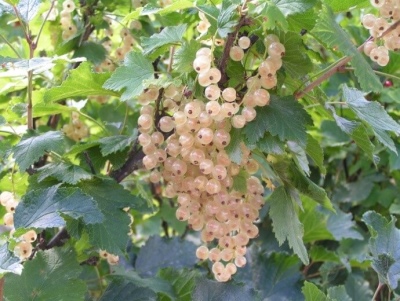
- Authors: Litvinova V.M., Smolyaninova N.K., FGBNU Federal Research Center of Horticulture
- Name synonyms: Diamond
- Year of approval: 2007
- Ripening terms: average ripening
- Growth type: medium-sized
- Yield: high
- Appointment: universal
- Berry weight, g: 0,4
- Tasting assessment: 4,0
- Escapes: medium, geniculate, brown-red, hairless
The White Fairy currant is still a fairly new crop. However, she has already managed to gain popularity and love of gardeners due to its easy care, excellent winter hardiness and satisfactory transport performance. Many people note its stable annual yield, sweet taste of berries, which are also very useful for strengthening the immune system.
Breeding history
They worked on the creation of the variety at the Federal State Budgetary Scientific Institution of the Federal Research Center of Horticulture. To obtain a new culture, well-known breeders N.K.Smolyaninova and V.M.Litvinova carried out a selection of hybrids from the fund of N.K.Smolyaninova. As a result, a new White Fairy currant was obtained, specially designed for the central regions of Russia. It has an official synonym - Diamond. The currant entered the State Register of Breeding Achievements of Russia in 2007.
Description of the variety
The currant bush The White Fairy is weakly spreading, its size is average, it grows no higher than 1 meter. If the color of the old branches is brown-red, then the new shoots have it brown-green, and they are of medium thickness. The dense leaves are usually small, while they can be 3-5-lobed. The middle part of the leaf is longer than the sides. The culture blooms with small pale flowers, their shape resembles a saucer. The brush has a length of 8 to 9 centimeters, and from 9 to 13 berries ripen in each brush.
Characteristics of berries
The berries of the currant in question are white in color, have a very thin transparent and shiny skin, and a rounded shape. The weight of each such berry is 0.4 g. They are collected in a brush.
Taste qualities
The berries of the White Fairy have a delicate sweet and sour taste. It also has a useful chemical composition:
- 6.8% of the amount of sugars;
- 2.2% titratable acid;
- 41.9 mg / 100 g of ascorbic acid.
Ripening and fruiting
The white currant of the described variety ripens from 15 to 30 July, thus being a medium-term crop. Early-fruiting: the first berries can be seen and tasted already 2-3 years after planting in the ground.

Yield
The White Fairy is a high-yielding currant, its productivity is 86.0 c / ha. And with proper care, each bush can yield up to 9 kilograms of amazing white fruit.
Growing regions
The variety is zoned for the Central region. Ideal for growing in Bryansk, Vladimir, Kaluga, Ivanovo, Moscow, Ryazan, Smolensk, Tula regions.
Landing
It is recommended to grow the white fairy in a sunny area. It should also be even, as well as protected from gusts of cold winds and drafts. Traditionally, currants are planted along fences, and this is the best place. The bushes will be well protected from any air currents.
The White Fairy variety does not tolerate a transplant. For this variety, it is unacceptable, therefore, the most suitable site is immediately selected. The soil should be loose and low-acid, preference is given to loam and sandy loam. The recommended groundwater bedding is below 1.2 m from the surface. If this is not possible, embankments are made for planting currants to avoid strong soil moisture.
When planting, the seedling is placed in the hole at an angle of 45 degrees. Then you need to spread the roots and sprinkle them with earth. After that, it should be tamped a little to remove possible air pockets. The soil around the trunk is mulched with straw, as well as wood ash or fresh soil to retain moisture.

Growing and care
White Fairy is a very moisture-loving variety. He will need regular watering. But at the same time, irrigation can be abandoned in early spring, because when the snow melts, there is a lot of liquid, as well as in summer, if there are heavy rains. During the period of setting fruits and pouring berries, water the culture once a week, at least. Moreover, the soil should be moistened to a depth of 30 to 40 cm. In this case, it is unacceptable to get liquid on foliage and fruits. In this case, you can use drip irrigation or special grooves. At the end of irrigation, it is necessary to carry out weeding and loosening.





Currant is one of the most favorite crops of gardeners, it can be found on almost any personal plot. In order for the currant berries to be tasty and large, and the bush itself to be healthy and strong, you should properly care for, treat and protect the plant from harmful insects. It is important to recognize the signs of the disease in a timely manner and begin treatment in the early stages of plant damage.










































































